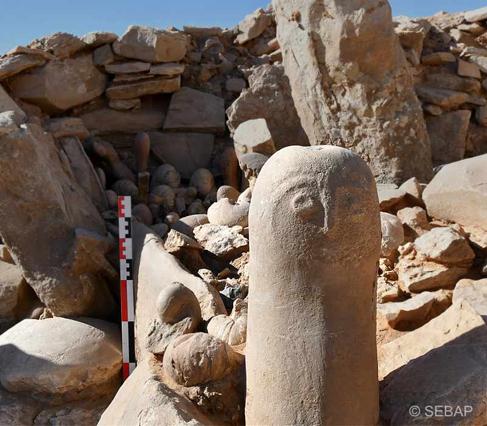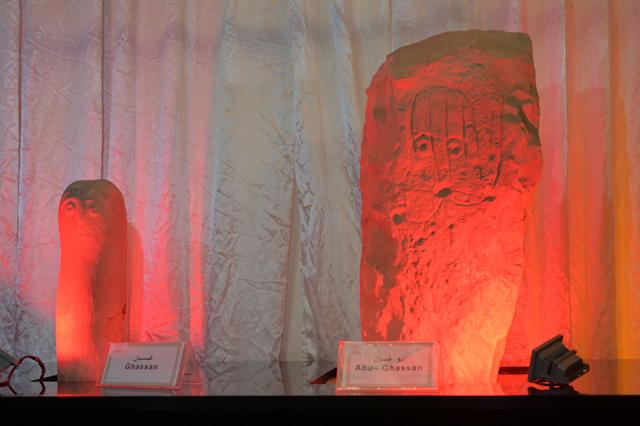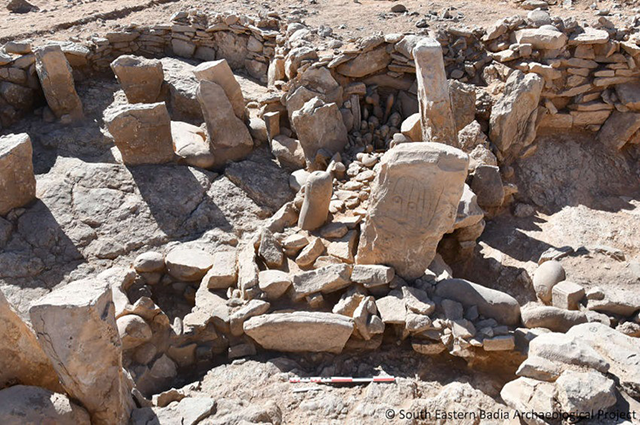You are here
Evidence of ritual sacrifice unearthed at Jabal Khashabiyah archaeological site, says scholar
By Saeb Rawashdeh - Aug 14,2022 - Last updated at Aug 20,2022

A detailed view of the two steles of ‘Abu Ghassan’ and ‘Ghassan’, with the ritual deposit of marine fossils at the background, at site JKSH P52, Jabal Al Khashabiyeh (Photo courtesy of SEBAP)
AMMAN — The Southeastern Badia Archaeological Project (SEBAP) focuses on late prehistory human developments in the arid margins of the so-called Fertile Crescent, noted Professor Mohammad Tarawneh of Al Hussein Bin Talal University at the 15th International Conference on the History and Archaeology of Jordan in Irbid.
SEBAP is a joint scientific project between Al Hussein Bin Talal University (Maan) and the French Institute for the Near East.
Recently, the research team has been studying various “desert kites”, or mega-constructions that consist of two long walls converging upon an enclosed space with small stone constructions called cells on its periphery, Tarawneh explained.
“The Jafr basin on the southeast is the main focus of the research, particularly Jabal Khashabiyah,” Tarawneh said, noting that Jabal Khashabiyah is a high plateau about 80km east of Al Jafr.
“In 2013, scholars discovered the first evidence of desert kites in this area,” the professor continued, further explaining that a kite has a wide opening and was intended to be a trap for wild animals.
During his presentation, “Symbolism, spirituality and cult of the Ghassanians: Discovery of a unique Late PPNB ritual installation dedicated to desert kites”, Tarawneh said that the survey allowed scholars to identify eight distinctive camp sites located on the edge of the plateau in the vicinity of the kites .
“We made a remarkable discovery: One of the stones had a carving which turned out to be a depiction of the kite. The engraving was made by a combination of multiple carving techniques,” he said.
Ghassanians were skillful hunters who utilised the desert kites to capture gazelles, ibex and other game animals, Tarawneh said, adding that scholars found anthropomorphic figurines at the site, suggesting religious importance.
“During the 2021 season, we discovered a complex ritual installation with an exceptionally preserved interior of the cultic structure. Two stelas at the site represented ritual installations, and marine fossils were found there as well. The stelas were anthropomophic representations of sacrificial offerings which were taking place inside the shrine,” Tarawneh said.
The installation has two standing stelas (“Abu Ghassan” and “Ghassan”): The tallest is 1.12 metres high and bears a depiction of a desert kite intermingled with a human figure that probably represents a huntsman, Tarawneh underlined, adding that the second standing stele is 70cm high and represents a human figure.
A structured deposit composed of nearly 150 carefully arranged marine fossils was unearthed, along with a variety of stones of unusual shape, as well as a number of animal figurines and exceptional worked flint objects, said Tarawneh.
“The altar and associated hearth suggest that some kind of sacrificial offerings must have been involved in the ritual process. The sacral symbolism and ritual performance evidenced were most likely devoted to the invocation of supranatural forces for successful hunts and abundance of prey to capture,” Tarawneh added.
Related Articles
AMMAN — Minister of Tourism and Antiquities Nayef Al Fayez on Tuesday announced the discovery of a "unique ritual installation" dedicated to
AMMAN — A research in the south-eastern desert began in 2013 when the “South Eastern Badia Archaeological Project” was established.In a remo
AMMAN — Al Jafr is a town located near Maan, in the south-eastern region of Jordan, within the area of Jibal Khashabiyeh.


















